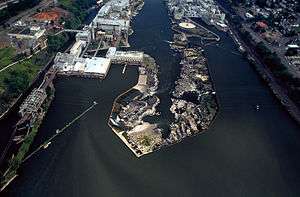T. W. Sullivan Hydroelectric Plant
Portland General Electric's (PGE) T. W. Sullivan Hydroelectric Plant is a hydroelectric dam on the Willamette Falls built between 1888 and 1895. It is the source of the nation's first long-distance power transmission.[1] The plant first opened with Station A in 1889. In 1895 a second powerhouse was built on the same dam, Station B, and Station A was removed. Station B. In 1953 Station B was renamed after the engineer who designed it and nearby paper mills, Thomas Sullivan. By that year, the plant was generating between 11,000 and 17,500 kilowatts, which it still does today.[2][3] PGE's Sullivan Plant at Willamette Falls is one of only a few dozen hydro-plants in the country officially designated as "Green."[4][5] In the 1920s a portion of the paper mill was put on top of the dam, which is still operating.



 Aerial View | |
| Status | Active |
|---|---|
| Construction began | 1888 |
| Opening date | June 3, 1889 |
| Built by | Willamette Falls Electric Power (PGE) |
| Designed by | Willamette Falls Electric Power (PGE) |
| Owner(s) | Portland General Electric |
| Operator(s) | Portland General Electric |
| Dam and spillways | |
| Spillways | 2 |
| Station B (T. W. Sullivan) | |
| Coordinates | 45.3514202°N 122.6196738°W |
| Pump-generators | Westinghouse, General Electric. |
| Website www.portlandgeneral.com | |
History
The oldest part of the dam is the 1873 Willamette Falls Locks. The rest was built later for Station A.
The first batch of generators installed in Station B were massive Westinghouse alternators. They were the largest alternators built at the time and Westinghouse claimed they probably would not last 10 years. PGE is proud to still be operating these alternators, with more modern casing. In 1911 several more Westinghouse alternators were added as well as a huge Allis-Chalmers generator 3 times the size of the first. A 1924 flood damaged half the turbines and the amount of generators had to be cut in half, including removal of the largest one. In 1953, two generators were replaced with smaller ones.


References
- Malee, Patrick. "120-plus years on, PGE T.W. Sullivan Plant continues to keep the lights on". https://joomlakave.com. External link in
|website=(help) - "Willamette Falls & Sullivan Plant History - Willamette River | PGE". www.portlandgeneral.com.
- https://www.hydroworld.com/content/dam/hydroworld/site-images/1406_HofFame_TWSullivan.pdf
- "LIHI Certificate #33 - Willamette Falls Project | Low Impact Hydropower Institute".
- To, Special (September 19, 2014). "Museum of the Oregon Territory of Oregon City presents Willamette Falls electrical history program". oregonlive.